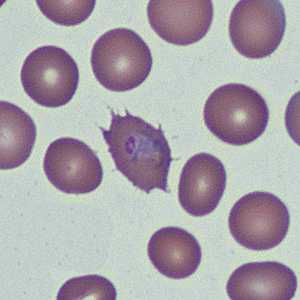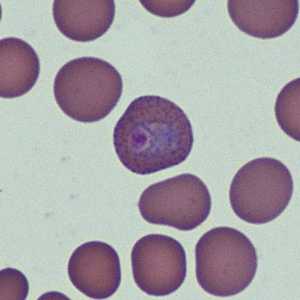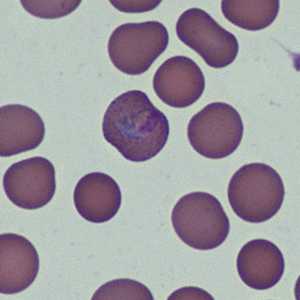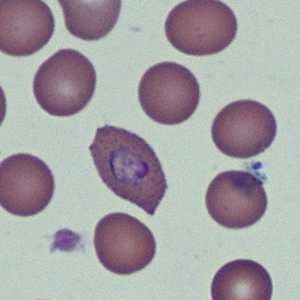
Case #368 - March 2014
An eight-year-old child presented to a hospital with intermittent fevers. He had recently returned from a trip to Kenya and had not taken anti-malarial prophylaxis while traveling. Blood was collected in EDTA and sent for hematologic work-up. A BinaxNOW malarial antigen test was performed and the result was negative. Thin smears were also made and stained with Wright-Giemsa. The attending technologist who read the smears took digital images of her findings and sent them to the DPDx Team for a telediagnosis consult. Figures A-D show four of the images received for analysis. What is your diagnosis? Based on what criteria?

Figure A

Figure B

Figure C

Figure D
Case Answer
This was a case of malaria caused by Plasmodium ovale. Diagnostic morphologic features included:
- compact developing trophozoites.
- Schüffner’s stippling (Figures B-D). Schüffner’s stippling is often less pronounced or absent in Wright-Giemsa stained smears than with traditional Giemsa-stained smears.
- elongation and fimbriation of infected RBCs (Figures A and D).
The negative result in the BinaxNOW antigen test could be due to the lower sensitivity of this test for P. ovale than for P. falciparum.
More on: malaria
This case and images were kindly provided by the University of Washington Medical Center, Seattle, WA.
Images presented in the monthly case studies are from specimens submitted for diagnosis or archiving. On rare occasions, clinical histories given may be partly fictitious.
DPDx is an education resource designed for health professionals and laboratory scientists. For an overview including prevention and control visit www.cdc.gov/parasites/.
- Page last reviewed: August 24, 2016
- Page last updated: August 24, 2016
- Content source:
- Global Health – Division of Parasitic Diseases and Malaria
- Notice: Linking to a non-federal site does not constitute an endorsement by HHS, CDC or any of its employees of the sponsors or the information and products presented on the site.
- Maintained By:


 ShareCompartir
ShareCompartir